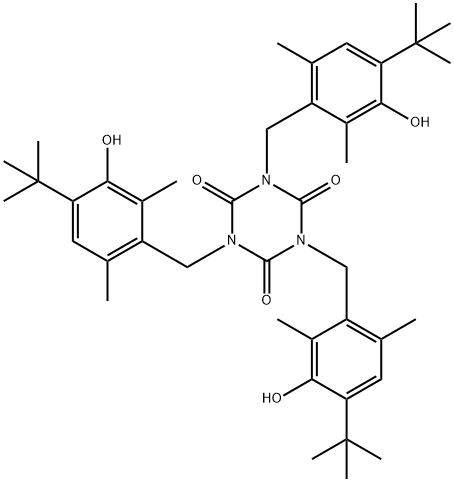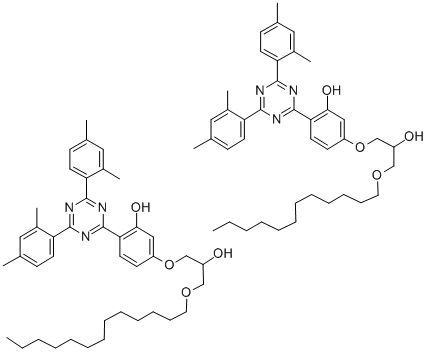3,9-Bis(2,4-dicuMylphenoxy)-2,4,8,10-tetraoxa-3,9-diphosphaspiro[5.5]undecane
- CAS NO.:154862-43-8
- Empirical Formula: C53H58O6P2
- Molecular Weight: 852.97
- MDL number: MFCD00274221
- EINECS: 421-920-2
- SAFETY DATA SHEET (SDS)
- Update Date: 2025-04-08 11:48:58
![3,9-Bis(2,4-dicuMylphenoxy)-2,4,8,10-tetraoxa-3,9-diphosphaspiro[5.5]undecane Structural](https://img.chemicalbook.in/CAS/GIF/154862-43-8.gif)
What is 3,9-Bis(2,4-dicuMylphenoxy)-2,4,8,10-tetraoxa-3,9-diphosphaspiro[5.5]undecane?
The Uses of 3,9-Bis(2,4-dicuMylphenoxy)-2,4,8,10-tetraoxa-3,9-diphosphaspiro[5.5]undecane
3,9-Bis(2,4-dicumylphenoxy)-2,4,8,10-tetraoxa-3,9-diphosphaspiro[5.5]undecane is an antioxidant, an adjuvant, food additive/food production aid. It is an antioxidant for polymers. It is widely used as stabilizer for polymers.
What are the applications of Application
3,9-Bis(2,4-dicumylphenoxy)-2,4,8,10-tetraoxa-3,9-diphosphaspiro[5.5]undecane is An antioxidant for polymers
General Description
3,9-Bis(2,4-dicumylphenoxy)-2,4,8,10-tetraoxa-3,9-diphosphaspiro[5.5]undecane an antioxidant for polymers. It is widely used as stabilizer for polymers.
Flammability and Explosibility
Not classified
Properties of 3,9-Bis(2,4-dicuMylphenoxy)-2,4,8,10-tetraoxa-3,9-diphosphaspiro[5.5]undecane
| Melting point: | 229-232 °C(lit.) |
| Boiling point: | 778.2±60.0 °C(Predicted) |
| Density | 1.26[at 20℃] |
| vapor pressure | 0Pa at 25℃ |
| storage temp. | -20°C Freezer, Under inert atmosphere |
| solubility | Chloroform (Slightly, Heated) |
| form | Solid |
| color | White to Off-White |
| Water Solubility | 50μg/L at 20℃ |
| EPA Substance Registry System | Bis(2,4-dicumylphenoxy) pentaerythritol diphosphite (154862-43-8) |
Safety information for 3,9-Bis(2,4-dicuMylphenoxy)-2,4,8,10-tetraoxa-3,9-diphosphaspiro[5.5]undecane
| Signal word | Warning |
| Pictogram(s) |
 Exclamation Mark Irritant GHS07 |
| GHS Hazard Statements |
H315:Skin corrosion/irritation H319:Serious eye damage/eye irritation H335:Specific target organ toxicity, single exposure;Respiratory tract irritation |
| Precautionary Statement Codes |
P261:Avoid breathing dust/fume/gas/mist/vapours/spray. P264:Wash hands thoroughly after handling. P264:Wash skin thouroughly after handling. P271:Use only outdoors or in a well-ventilated area. P280:Wear protective gloves/protective clothing/eye protection/face protection. P302+P352:IF ON SKIN: wash with plenty of soap and water. P305+P351+P338:IF IN EYES: Rinse cautiously with water for several minutes. Remove contact lenses, if present and easy to do. Continuerinsing. |
Computed Descriptors for 3,9-Bis(2,4-dicuMylphenoxy)-2,4,8,10-tetraoxa-3,9-diphosphaspiro[5.5]undecane
| InChIKey | WBWXVCMXGYSMQA-UHFFFAOYSA-N |
New Products
2-Propanamine, 1-chloro-, hydrochloride (9CI) 3-Pyridineacetonitrile, α-hydroxy- 3-Iodophenylacetic acid 3-(hexyloxy)-4-(pyridin-3-yl)-1,2,5-thiadiazole 2-Hexyn-1-ol Dibenzo-18-crown-6 9-Anthracenemethanol, 97% Giemsa Stain, Modified Solution 1-Propynylmagnesium bromide 5-Bromo-1,2,3-trichlorobenzene, 95% 1-Bromo-4-chlorobenzene, 99% Benzocaine, 98% N N' DimethylEthylenediamine Lead II Bromide Variamine Blue B Diazonium salt Ethyl Methanesulfonate N Ethylmethylamine N N N'Trimethyl ethylenediamine (R)-2-Methylpyrolidine-2-carboxylic acid (De Mepro) Boc Leucine Boc-L-Tyr(tBu)-OH Fmoc-L-Glu-OtBu Sacubitril- Valsartan RamiprilRelated products of tetrahydrofuran








You may like
-
![3,9-Bis(2,4-dicumylphenoxy)-2,4,8,10-tetraoxa-3,9-diphosphaspiro[5.5]undecane CAS 154862-43-8](https://img.chemicalbook.in//Content/image/CP5.jpg) 3,9-Bis(2,4-dicumylphenoxy)-2,4,8,10-tetraoxa-3,9-diphosphaspiro[5.5]undecane CAS 154862-43-8View Details
3,9-Bis(2,4-dicumylphenoxy)-2,4,8,10-tetraoxa-3,9-diphosphaspiro[5.5]undecane CAS 154862-43-8View Details
154862-43-8 -
 23434-88-0 Tetrahydropiperin 98%View Details
23434-88-0 Tetrahydropiperin 98%View Details
23434-88-0 -
 101-69-9 Variamine Blue B Diazonium salt 98%View Details
101-69-9 Variamine Blue B Diazonium salt 98%View Details
101-69-9 -
 142-25-6 98%View Details
142-25-6 98%View Details
142-25-6 -
 N N' DimethylEthylenediamine 98%View Details
N N' DimethylEthylenediamine 98%View Details
110-70-3 -
 N Ethylmethylamine 624-78-2 98%View Details
N Ethylmethylamine 624-78-2 98%View Details
624-78-2 -
 62-50-2 Ethyl Methanesulfonate 98%View Details
62-50-2 Ethyl Methanesulfonate 98%View Details
62-50-2 -
 10031-22-8 98%View Details
10031-22-8 98%View Details
10031-22-8
Statement: All products displayed on this website are only used for non medical purposes such as industrial applications or scientific research, and cannot be used for clinical diagnosis or treatment of humans or animals. They are not medicinal or edible.
